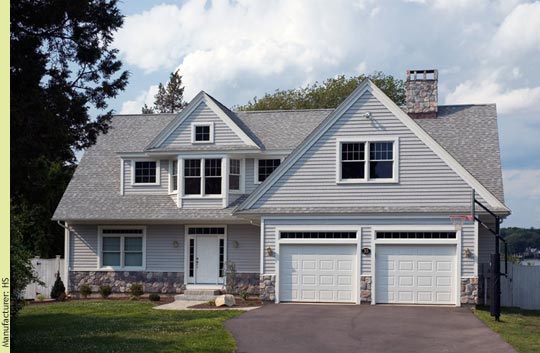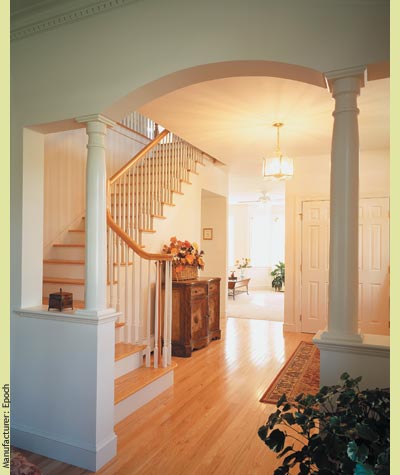|
A brief summary of Chapter 10 "Warranty Service" (11 pages) in The Modular Home, by Andrew Gianino, President of The Home Store Warranty-service work is needed at some point on virtually every new house. The imperfections of materials and people inevitably create the need. The hundreds of different materials that make up a house don't always respond as they were designed, sometimes causing undesirable results. The human beings that build homes bring different abilities and attitudes to their work, occasionally creating unacceptable quality. Dealers, manufacturers, and general contractors work hard to prevent quality problems and avoid mistakes, but they also have created a mechanism to address them. That is the function of the warranty. What distinguishes good companies is the extent to which they assume full responsibility for correcting warranty-service problems in their customers' homes. Since this policy is costly, most of these companies also continually try to improve their organizations to reduce the number of warranty items. Over time, they build a company that has fewer warranty claims than other companies. Most builders of stick, panelized, and log homes provide the minimum warranty mandated by law. In most states, this is one year. Most modular manufacturers offer an extended warranty, which usually adds a two-year warranty for mechanical systems and a ten-year warranty for structural systems. These extended warranties express a great deal of confidence by the modular industry in its homes. Although it is comforting to know you have this extra insurance, the likelihood is you will never have reason to use it for any serious problem. You will, however, almost certainly need warranty-service coverage for other matters. The first time you might need help is immediately after your home is delivered and set. This will be the first opportunity to see your home and identify any mistakes, defects, or damages. The button-up phase creates a second phase of warranty-service coverage, which requires the dealer, manufacturer, and GC to work together to resolve any issues that develop. The final phase begins after you move into your new home. 
Custom design created by architect Rob Coolidge
When you buy a modular home, you expect it to arrive without mistakes, defects, or damaged materials. If you discover any, you expect the manufacturer to repair or replace them. You also expect the manufacturer to do this at no cost to you. Manufacturers usually understand these expectations, but they have a few of their own. They accept responsibility for problems found when your home arrives, but they expect your dealer, as well as you and your GC, to accept responsibility for any damages incurred after that. This seems fair, and in principle it is. When you purchase your home from a dealer who completes the GC work, your expectations are likely to be met. When the dealer and GC are separate companies, however, the situation can trigger contention and distrust. A modular home is typically built with most of its interior complete. Walls, cabinets, tubs, doors, moldings, and electrical outlets are almost always installed at the factory. All of these products can be damaged accidentally, and this can happen as easily at the factory as at your site. Your home is thoroughly inspected before it leaves the factory. The manufacturer tries to repair or replace any defective or damaged goods before shipping the home. When that is not possible without causing a delay, the manufacturer documents the problem, makes plans to fix it at your site, and informs the dealer so that you are not surprised. Either way, the inspection enables the manufacturer to document any warranty problems with your home. The inspection, however, does not preclude disagreements between the manufacturer, dealer, and GC. If you discover any damage to your home after it is delivered and set, it could have been caused by the manufacturer even though it is not listed on the inspection report. But it could also have been caused by someone on your site. This chapter explains the procedures employed by most dealers and manufacturers to manage this situation in a way fair to everyone. Before the manufacturer ships your home, it will place some materials into one or more of the modules. The GC will use these ship-loose materials to complete the button-up of the modules and the construction of site-built structures, such as a garage or porch. This chapter explains the procedures used to ensure that you receive the correct materials. Once the GC begins the button-up of your home, he must inform your dealer if he discovers any missing, defective, damaged, or poorly installed materials that were not identified during the set-day inspection. The dealer will then notify his manufacturer, who will determine the corrective action. This chapter offers several reasons why the GC should not take any corrective action until he hears from the dealer. Understanding these reasons will help you and your GC avoid costly expenses, since the dealer and manufacturer are unlikely to reimburse you if the GC does the unauthorized work and presents you with a bill. This chapter also tackles the following additional warranty issues:
-
Should the GC report a warranty-service issue directly to you or the dealer?
-
When is a manufacturer most willing to allow your GC to complete some of the warranty work?
-
What is likely to happen if your GC discovers and reports some damage to your modular home several weeks after the official inspection period?
-
What do you do if you need emergency service?
-
What do you do if you disagree with your dealer or GC about whether something in your home is defective, damaged, or poorly installed?
If you discover any mistakes, defects, or damages involving your GC's work during the button-up of your home, report this directly to the GC. He will want to correct the items during the course of his work, since he cannot bill you in full for his services until he has done so. Before making the final payment to your GC and moving into your new home, do a walk-through inspection with the GC to be certain it is complete and finished to your satisfaction. Use the walk-through to point out any items that need additional work or correction, including exterior finishes and site work. If you have been keeping an eye on the work as it progressed, there should be few of these problems. Have the GC document any problems in writing, and try to have the work completed before you move in. Decide on a monetary value for the correction, and hold back 150 percent of this amount from the final payment until the work is done. Any nonemergency items discovered after the inspection but before you move in should be added to a new list that can be completed with other items you discover after you move in. During the walk-through inspection, have the GC show you how to use any new or unusual features and systems in your new home. This chapter provides a sample checklist for your GC to use as a guide. Ask the GC to explain how to turn off the master switch on the electrical panel box and where to find the emergency shut-off switch for the heating system. Many of the products and systems installed by your GC will come with their own component warranties. The GC should provide you with the written warranty documentation for each product, and you should remember to complete and mail the warranty registration cards included with the materials. The GC should remind you to finish any jobs you assumed responsibility for, and he should discuss your maintenance responsibilities as homeowner. The GC should review his warranty procedures, paying particular attention to how you should deal with emergencies and report routine items. He should leave you a form that lists the names and phone numbers you should call in case of emergencies. Put this in a place where it can be easily accessed, such as the inside of the kitchen-sink cabinet door. 
A sunlit passageway made elegant with a simple arch and columns
After moving into your home, you will almost certainly find problems that need fixing under warranty. This chapter recommends a few procedures to help your dealer, GC, and you handle these issues. Homeowners have a few warranty obligations that must be taken seriously, especially those relating to normal maintenance and care. A good overview of the homeowner's responsibilities can be found in a booklet by the National Association of Home Builders titled, "Your New Home and How to Take Care of It." One responsibility often ignored by homeowners is the obligation to contact the appropriate party in a timely fashion when a warranty situation is discovered. Even a simple warranty issue can become serious and require an expensive fix when you delay reporting it. For example, if your front door leaks a little water every time it rains because the threshold needs to be adjusted, the finished flooring and framing can quickly become damaged. Modular homes are strong, but they are not indestructible. Expect your home to show signs of normal wear and tear over time, and accept responsibility for fixing the inevitable results. You will want to restore your home to as-new-as-possible condition after the first heating season, since most of the settling and drying of wood will have occurred by that point. In a typical home, completing this tune-up usually takes a day or two by someone who has carpentry, drywall, and painting skills. Some of these normal changes will reappear in subsequent years, but they should be less noticeable and easier to repair. This chapter recommends how to obtain help from your dealer and GC to complete these repairs. It also offers some recommendations about applying a finished coat of paint and wallpaper. In addition, it discusses what you can do when condensation builds up in your home and wood doors, trim, and floors expand and contract. After your warranty expires, you should continue to take care of normal homeowner maintenance tasks. Most people find it is best to develop a list of tasks to do each season. For example, they clean the gutters and downspouts every spring and replace the batteries in the smoke and carbon-monoxide detector every fall. Your modular home will last several generations, if you maintain it well. Chapter Index To learn more about building a modular home, read excerpts from the other chapters of The Modular Home, (325 pages) by Andrew Gianino, President of The Home Store:
Chapter 1: Why Build Modular
Chapter 2: Selecting a Dealer
Chapter 3: Designing a Home
Chapter 4: Specifications and Features
Chapter 5: Selecting a General Contractor
Chapter 6: Finding and Preparing a Building Lot
Chapter 7: The General Contractor's Responsibilities
Chapter 8: Building a Modular Addition
Chapter 9: Financing a Modular Home
Chapter 10: Warranty Service
Chapter 11: Building on Schedule
To purchase a complete copy of The Modular Home, click here.
|

